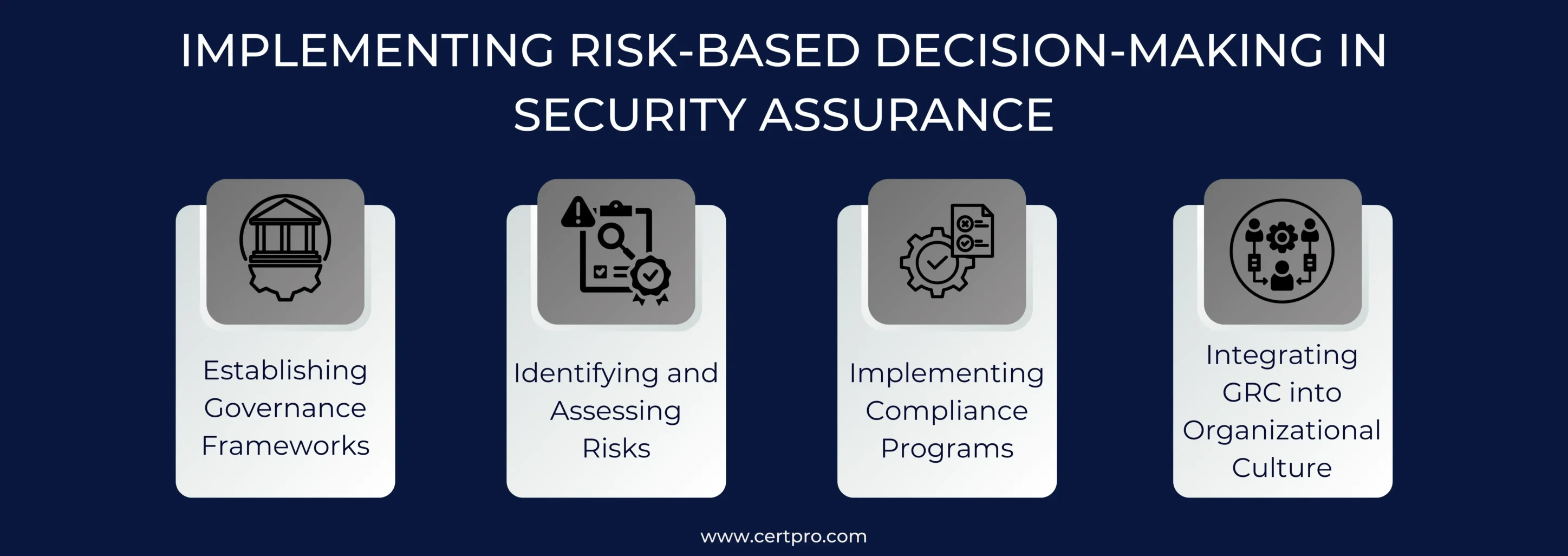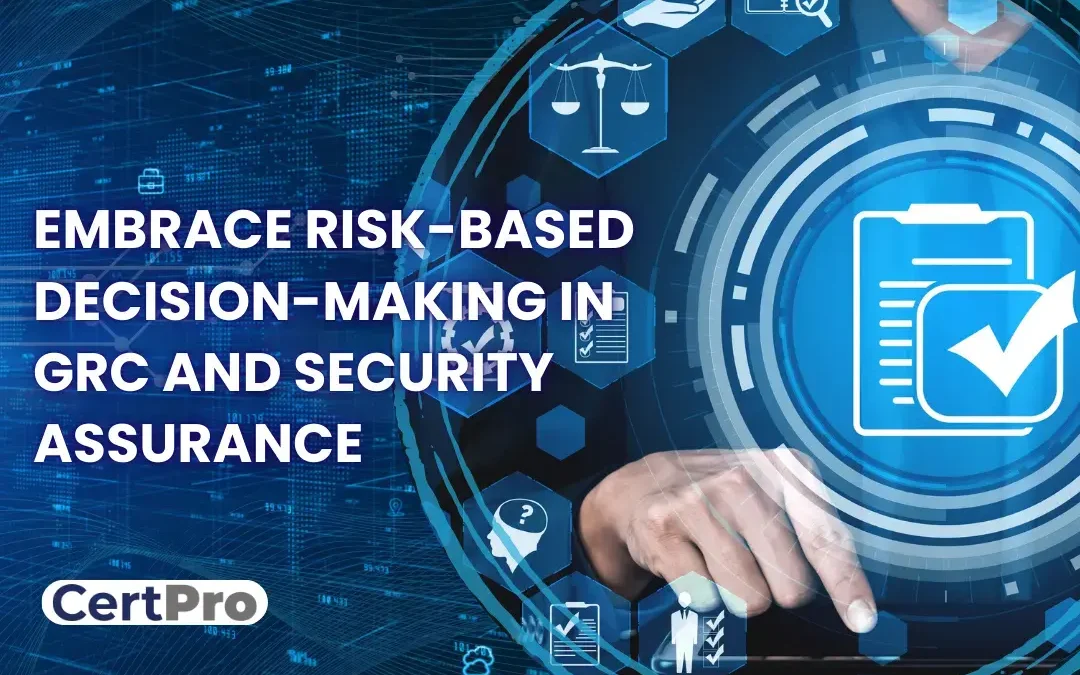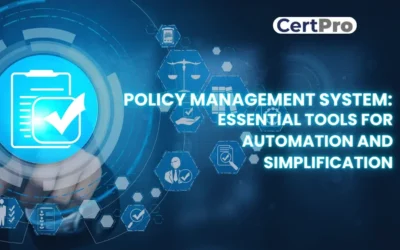GRC and security assurance are essential for modern businesses’ thriving digital security. The process helps to improve your organization’s security posture and comply with the regulatory framework. In addition, GRC strategies allow the organization to coordinate with technologies and act ethically. An effective GRC program can change traditional approaches to risk and compliance. The process also eliminates incidents of miscommunication and inefficiencies in the department. Therefore, implementing risk-based decision-making in GRC and security assurance removes the risk of potential threats and ensures cyber security.
In this article, we will discuss the GRC framework and security assurance. Again, we will briefly discuss the importance of GRC and how to implement a risk-based decision-making process in security assurance.
UNDERSTANDING THE GRC FRAMEWORK
In one model, GRC combines the governance, risk management, and compliance processes. In the past, businesses have practiced them separately to achieve the result. Thus, when applied together, the combination process rescues the wastage, inefficiency, and non-compliance risk.
Governance: Governance is a set of policies and rules businesses must follow to achieve the desirable goal. In addition, governance defines the responsibilities of stakeholders to improve the company’s social responsibility. Effective governance enhances an organization’s ethics and accountability. It also helps with transparent communication, conflict resolution, and resource management.
Risk Management: Organizations can face different kinds of risks. Therefore, proper risk management helps businesses identify risks and find mitigation strategies. For instance, an appropriate risk assessment enables you to determine the security risk of your data handling process. Thus, the evaluation requires prompt action to eliminate the risk.
Compliance: It is an action governed by the following rules and regulations. The process follows legal and industry-related security rules. Therefore, GRC implements the process to ensure that the organization complies with the rules. For example, the healthcare section must follow the HIPAA rules, whereas cloud-based companies must follow SOC 2 regulations.
COMPREHENDING THE SECURITY ASSURANCE
Security assurance refers to the effectiveness of security measures to protect the organization’s information systems, including policies, procedures, and mitigation strategies. In addition, security assurance plays a vital role in developing trust between stakeholders and taking appropriate steps to safeguard sensitive data. Some critical aspects of security assurance include:
Risk Management: Assessing, identifying, and mitigating the potential threats to the data.
Security Policies: Creating and implementing robust security policies, guidelines, and processes to minimize security risks.
Security Controls: Using technical and administrative controls to protect information assets.
Audits and Assessments: Perform regular internal and external audits to demonstrate the effectiveness of security controls.
Incident Response: Select a well-defined incident response plan to handle security breaches.
Continuous Monitoring: Analyzing system logs, user activity, and network traffic for signs of malicious activity.
Compliance: Securing that the organization meets relevant legal, regulatory, and industry standards for information security.
Therefore, organizations can increase their assurance levels by focusing on these aspects. It demonstrates a solid commitment to protecting information systems and data from cyber threats.
IMPORTANCE OF GRC IN SECURITY ASSURANCE
Businesses can make better choices when using GRC systems. Therefore, an effective GRC program helps everyone involved make decisions about fair policies that follow the rules. These are some reasons your company should use a complete system:
Data-Driven Decision-Making: GRC helps you to make faster, fact-based decisions by monitoring your resources and establishing rules or frameworks.
Responsible Operations: GRC organizes work around a shared culture that encourages moral behavior and provides growth opportunities. Thus, it helps build a strong business mindset and ensures that ethical decisions are made in the company.
Improved Cybersecurity: Businesses can use data security steps to keep customer data safe using an integrated GRC system. Thus, your company needs a system because cyber risks are rising, and users’ data and safety are at risk. It makes businesses follow privacy rules like the General Data Protection Regulation (GDPR). Hence, it improves customer trust and growth in business opportunities.
IMPLEMENTING RISK-BASED DECISION-MAKING IN SECURITY ASSURANCE
The following steps can be followed in implementing the GRC in security assurance.
Establishing Governance Frameworks: Setting up governance guidelines is the first step in making a GRC program. Therefore, governance is the rules, policies, and processes that tell people how to run a company. Thus, GRC governance models help businesses set up ways to make risk-based decisions to meet their business goals. The framework should explain how the board will control the GRC, how the company will handle risks, how it will ensure it follows all laws and rules, and how to deal with incidents or breaches.
Identifying and Assessing Risks: Finding and evaluating risks is the second part of a strong GRC plan. Thus, you need to know your organization’s risks and how they might affect it. Again, a thorough risk assessment will help you determine which risks are the most important to your business and put them in order of importance. Therefore, steps must be taken to manage and monitor the risks.
Implementing Compliance Programs: Compliance means ensuring your business follows the rules per the industry’s needs. Thus, you must set up a complete compliance strategy to create a successful program. This framework should list the areas where the organization has to follow legal and regulatory rules. Hence, it should also explain how compliance will be measured and the risks related to non-compliance.
Integrating GRC into Organizational Culture: The fourth part of a system is adding GRC to the organization’s culture. Businesses should create a mindset of risk knowledge, accountability, and compliance. Thus, it is also essential that all employees know what they need to do when GRC is implemented. The company can take a more proactive approach to managing and reducing risks by embracing a GRC mindset.

BEST PRACTICES FOR EMBRACING RISK-BASED DECISION-MAKING
Implementing a GRC model can seem complicated because it usually involves checking the current processes and methods for errors. Therefore, each established part of the company may have its way of conducting risk assessments or monitoring compliance. However, the best way is to work together and share the knowledge. Five things can help your company set up a system.
Prioritize the Discovery Phase: If you want the GRC program to work, you must examine how things are done now. Thus, different departments and teams will use various methods, but the goal is to find areas of agreement. What the internal audit finds will help decide the direction of the whole GRC project. Also, it is essential to list all the rules, policies, and laws the organization may have to follow.
Role of Senior Management: Top management should notice the benefits of a uniform GRC approach. It ultimately helps in data access and creates a strategy. Additionally, senior management should clarify the company’s overall goals and plan. If the board can agree on a single GRC plan, the project will fit better into the company.
Streamline the Process: GRC tools will help streamline the process. Therefore, GRC software can keep all risk reviews and internal reports in one place. The software will also help you keep track of the steps and processes used by different teams. Businesses can look into the trends occurring in other teams by streamlining the processes.
Improve Business Performance: A GRC program’s primary goal is to improve risk assessment and compliance tracking, which are critical for a business’s long-term growth. Therefore, risk management directly affects business growth choices. This can be achieved by sharing resources between teams and departments to save time and capital.
Define Objectives: Employees should be updated on the goals and able to understand them. Thus, employees need training and guidance to use a GRC system. In addition, any technological changes must be addressed for the program to function correctly.
FUTURE OF GRC SOFTWARE AND TOOLS
Governance, risk, and compliance systems usually combine technologies to manage core tasks from a single platform. A GRC tool can help organizations establish a structured management method to ensure policy compliance and tracking. Therefore, the software should include finding the tools and techniques that handle these risks and integrating them with the company’s current business management software.
Moreover, GRC tools can also help businesses follow the rules and laws. In addition, the systems often have tools to help you handle risks related to operations, IT, and vendors. GRC companies have added automation and AI-based features to their tools to make them easier to use and help businesses keep up with risk changes.
FINAL THOUGHTS
Organizations have started risk and compliance programs across the whole company because of stringent rules, complicated businesses, and a greater focus on responsibility. However, these processes are not organized in a time when risks are linked and controls are shared. This causes a massive waste of effort and resources for the businesses. These programs can work together and solve problems with the help of GRC systems that control, define, enforce, and monitor them. CertPro offers you the most complete solution today to simplify your compliance journey. It supports a wide range of compliance initiatives for different industries. CertPro aims to provide you with a powerful platform to continue your business. For more details, please contact us on our website, CertPro.com.
FAQ
Is GRC cybersecurity?
What is the difference between GRC and security?
Is SAP a GRC tool?
What is the GRC roadmap?
What is the future of GRC?

About the Author
Shivaprasad Shetty
Shivaprasad Shetty is an ISMS Lead Auditor and Consultant, adept at developing, implementing, and auditing ISO 27001-compliant frameworks. He is also well-versed in SOC 2 compliance, GDPR, HIPAA, and ISO 42001 standards. Shivaprasad excels in ensuring compliance across regulatory frameworks and fostering a secure organizational culture.
IT COMPLIANCE IN 2024: ESSENTIAL TRENDS AND BEST PRACTICES
IT compliance is essential for every organization to secure the integrity and accountability of data. The process also helps develop the business and enhance its profitability. In today’s digital era, IT compliance has more than just a regulatory checkbox. It plays a...
POLICY MANAGEMENT SYSTEM: ESSENTIAL TOOLS FOR AUTOMATION AND SIMPLIFICATION
Growing businesses indicates that you become a master in your field and accurately manage all business-related policies. However, managing company policies can be daunting significantly when your business expands. Here, an effective policy management system can help...
NAVIGATING DATA PRIVACY FRAMEWORKS: A COMPREHENSIVE GUIDE
Globalization has intense effects on business functioning and scaling. In today's digital world, companies are generating an unprecedented rate of data that requires protection from emerging cyber threats. In addition, recurring data breaches and privacy concerns make...




